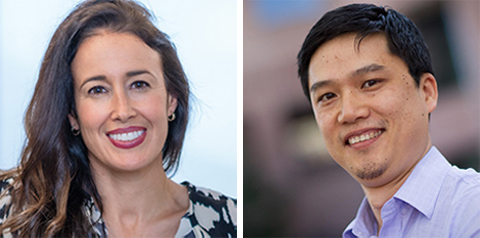Unraveling oncogenesis: What makes cancer tick?
Recent discoveries in cancer biology may bring forward an additional collection of tools in physicians’ arsenal of cancer therapeutics. Scientists now know that many cancer-associated mutations affect chromatin regulation and the function of multiprotein transcriptional complexes, which can ultimately lead to cancer development and growth. This knowledge may be used to develop future clinical approaches.

The ASBMB annual meeting is around the corner, and attendees can expect a wide variety of symposia offerings throughout the event. One of the symposia, oncogenic hubs: chromatin regulatory and transcriptional complexes in cancer, will focus on the role of transcriptional dysregulation, histone modification and chromatin regulatory complexes in cancer formation. Cigall Kadoch of Harvard Medical School and Greg Wang of Duke University School of Medicine organized and will lead the session.
Wang, a current Journal of Biological Chemistry editorial board member and 2022 ASBMB Young Investigator Award recipient, said the symposium will focus on cancer but encouraged attendees from all fields to participate in the session.
“These topics can be applied to many other diseases as well,” Wang said.
According to Kadoch, the topics covered at the symposium directly relate to patient care and developing novel therapeutic approaches.
“We’re at a unique moment in time in which the learnings from first-in-class approaches in the clinic are coming back to the bench to inform new questions and propel next-step advances,” Kadoch said. “(We) hope this section of the ASBMB meeting does a good job of covering that.”
Wang added: “(This field) elevates basic science to the translational level to ultimately benefit patients.”
Kadoch and Wang selected a diverse array of speakers who study the role of molecular condensates, extrachromosomal DNA, chromatin regulatory machinery, epigenetics and more in cancer.
“I am particularly excited about the interplay of the speakers within the section and the opportunity for our audiences to take away numerous new approaches to exploring some of the most pressing biological questions relating to oncogenic hubs,” Kadoch said.
Check out the full program schedule to get the most out of #ASBMB25.
Enjoy reading ASBMB Today?
Become a member to receive the print edition four times a year and the digital edition monthly.
Learn moreFeatured jobs
from the ASBMB career center
Get the latest from ASBMB Today
Enter your email address, and we’ll send you a weekly email with recent articles, interviews and more.
Latest in Science
Science highlights or most popular articles

Building the blueprint to block HIV
Wesley Sundquist will present his work on the HIV capsid and revolutionary drug, Lenacapavir, at the ASBMB Annual Meeting, March 7–10, in Maryland.

Gut microbes hijack cancer pathway in high-fat diets
Researchers at the Feinstein Institutes for Medical Research found that a high-fat diet increases ammonia-producing bacteria in the gut microbiome of mice, which in turn disrupts TGF-β signaling and promotes colorectal cancer.

Mapping fentanyl’s cellular footprint
Using a new imaging method, researchers at State University of New York at Buffalo traced fentanyl’s effects inside brain immune cells, revealing how the drug alters lipid droplets, pointing to new paths for addiction diagnostics.

Designing life’s building blocks with AI
Tanja Kortemme, a professor at the University of California, San Francisco, will discuss her research using computational biology to engineer proteins at the 2026 ASBMB Annual Meeting.

Cholesterol as a novel biomarker for Fragile X syndrome
Researchers in Quebec identified lower levels of a brain cholesterol metabolite, 24-hydroxycholesterol, in patients with fragile X syndrome, a finding that could provide a simple blood-based biomarker for understanding and managing the condition.

How lipid metabolism shapes sperm development
Researchers at Hokkaido University identify the enzyme behind a key lipid in sperm development. The findings reveal how seminolipids shape sperm formation and may inform future diagnostics and treatments for male infertility.

